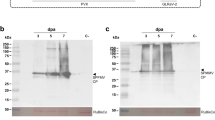Abstract
Binding characteristics of Hyphantria cunea nuclear polyhedrosis virus (HcNPV) to Spodoptera frugiperda 21 (Sf21) cells was determined. The cells displayed an affinity of 0.9 × 1010 M-1 with about 8900 binding sites per cell. The biochemical nature of HcNPV-binding sites on the cell surface was also partially elucidated. There were 45 to 49% reductions in HcNPV binding following the pretreatment of cells with three proteases, suggesting the involvement of a cellular protein component in virus binding. Tunicamycin, which inhibits N-linked glycosylation and the expression of some membrane proteins on the cell surface, reduced virus binding suggesting a role for glycoprotein(s) in binding. Treatment of cells with wheat germ agglutinin or neuraminidase did not measurably reduce virus binding, indicating that oligosaccharides containing N-acetylglucosamine or sialic acid are not directly involved in HcNPV attachment. The negative effect of methylamine on HcNPV binding seems to be due to the fact that HcNPV entry via an endocytic pathway is blocked by the increased pH of the endosome. Data on energy inhibitors (sodium azide and dinitrophenol) indicates that HcNPV attachment to Sf21 cells may be closely linked to viral entry via receptor-mediated endocytosis. These findings suggest that the binding site moiety has a glycoprotein component, but that direct involvement of oligosacccharides containing N-acetylglucosamine or sialic acid residues in binding is unlikely, and that HcNPV attachment to Sf21 cells might be via receptor-mediated endocytosis.
Similar content being viewed by others
References
Choe YK, Byun SM, Lee HH, Chung TW, Park HY and Kang SK (1986) A nuclear polyhedrosis virus of Hyphantria cunea replicates in vitro. Biotechnol Lett 8: 853–858.
David RO, Miller LK and Luckow VA (1992) Baculovirus expression vector. WH Freeman and Co., NY.
Elbein AD (1987) Glycosylation inhibitors for N-linked glycoproteins. Methods in Enzymology 138: 661–709.
Horton HM and Burand JP (1993) Saturable attachment sites for polyhedron-derived baculovirus on insect cells and evidence for entry via direct membrane fusion. J Virol 67: 1860–1868.
Jin YM, Pardoe IU, Burness ATH and Michalak TI (1994) Identification and characterization of the cell surface 70-kilodalton sialoglycoprotein(s) as a candidate receptor for encephalomyocarditis virus on human nucleated cells. J Virol 68: 7308–7319.
Kaljot KT, Shaw RD, Rubin DH and Greenberg HB (1988) Infectious rotavirus enters cells by direct cell membrane penetration, not by endocytosis. J Virol 62: 1136–1144.
Kim TY, Park JH, Park JO, Kang HC and Chung IS (1997) Biochemical analysis of BmNPV attachment to Bombyx mori cells. In: Funatsu et al. (eds.) Animal Cell Technology: Basic and Applied Aspects. Kluwer Academic Publishers, The Netherlands, 8: 203–207.
Lee HH (1987) Replication and cloning of Hyphantria cunea nuclear polyhedrosis virus in Spodoptera frugiperda cell line. Hanguk Journal of Genetic Engineering 2: 1–6.
Lee HH and Lee KK (1988) Isolation, complementation and partial characterization of temperature-sensitive mutants of the baculovirus Hyphantria cunea nuclear polyhedrosis virus. J Gen Virol 69: 1299–1306.
Lee HH and Lee KK (1991) The DNA genome and viral protein analysis of Hyphantria cunea nuclear polyhedrosis virus. Mol Cells 1: 241–244.
Lee HH and Miller LK (1978) Isolation of genotypic variants of Autographa californica nuclear polyhedrosis virus. J Virol 27: 754–767.
Reed L and Muench H (1938) A simple method for estimating fifty percent endpoint. Am J Hyg 27: 493–497.
Volkman LE, Goldsmith PA and Hess RT (1986) Alternate pathway of entry of budded Autographa californica nuclear polyhedrosis virus: fusion at the plasma membrane. Virology 148: 288–297.
Wang X and Kelly DC (1985) Baculovirus replication: Uptake of Trichoplusia ni nuclear polyhedrosis virus particles by insect cells. J Gen Virol 66: 541–550.
Wickham TJ (1991) Baculovirus-insect cell interactions in producing heterologous proteins: attachment, infection and expression in different cell lines. Ph. D. Thesis, Cornell University.
Wickham TJ, Shuler ML, Hammer DA, Granados RR and Wood HA (1992) Equilibrium and kinetic analysis of Autographa californica nuclear polyhedrosis virus attachment to different insect cell lines. J Gen Virol 73: 3185–3194.
Yu H, Soong N and Anderson WF (1995) Binding kinetics of ecotropic (moloney) murine leukemia retrovirus with NIH 3T3 cells. J Virol 69: 6557–6562.
Rights and permissions
About this article
Cite this article
Park, J.O., Chang, K.H., Lee, H.H. et al. Biochemical analysis of Hyphantria cunea NPV attachment to Spodoptera frugiperda 21 cells. Cytotechnology 31, 159–163 (1999). https://doi.org/10.1023/A:1008007818967
Issue Date:
DOI: https://doi.org/10.1023/A:1008007818967




